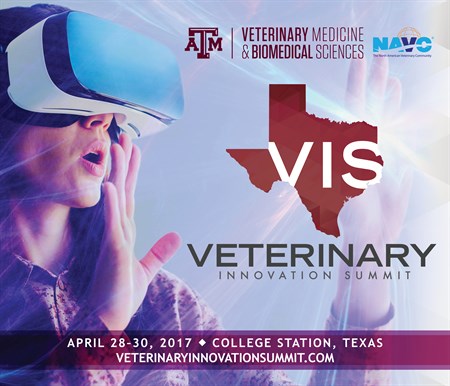The Texas A&M, North American Veterinary Community Launch Inaugural Veterinary Innovation Summit
Thought leaders flock to College Station, Texas, this week for unprecedented Veterinary Innovation Summit.

COLLEGE STATION, TX -The Texas A&M; College of Veterinary Medicine & Biomedical Sciences and the North American Veterinary Community (NAVC) welcome game-changers, innovators, entrepreneurs, and visionaries to the Veterinary Innovation Summit this weekend in College Station. At this event, veterinary and non-veterinary entrepreneurs and health professionals will share fresh perspectives on the latest technologies, debate controversial issues, foster new ideas , and catapult the profession into the future with fearlessness and innovation.
Dedicated to sparking and fostering ingenuity, the Veterinary Innovation Summit features a combination of unique programming, a diverse attendee pool, and an immersive learning environment for veterinary professionals at Texas A&M.;
“It is clear that the world is changing, not just at a linear rate, but exponentially, and these changes are having a profound effect on veterinary medicine, as they are on the rest of the world,” said Dr. Eleanor M. Green, the Carl B. King Dean of Veterinary Medicine at the CVM. “This summit brings together a diverse group of forward-thinking, innovative veterinarians and non-veterinarians, such as health professionals, engineers, entrepreneurs, regulators, and more. Together they will explore how veterinary medicine will not just respond to these changes, but will lead them, prosper from them, and ultimately make our word healthier.”
“We are entering an incredibly exciting time for our profession,” said Dr. Adam Little, director of Veterinary Innovation and Entrepreneurship at Texas A&M; University. “The acceleration of technologies–such as artificial intelligence, the internet of things, biotechnology, genomics, big data, and ubiquitous computing–present veterinarians with the opportunity to deliver more personalized, accessible, and ultimately impactful care to all species and stakeholders.”
However, this pace of change is accelerating and traditional approaches to education, research, and service are proving no longer sufficient. From Kodak to Instagram, Blockbuster to Netflix, Hotels to AirBnb, industries are being upended by this pace of change. Our care model is outdated, student debt is overburdening, career diversity is limited, and veterinary fulfillment and satisfaction remains too low.
“A new model of learning is required, one which harnesses the disruptors working at the fringes of our profession, including startup founders, academics, and thought leaders,” said Little. “This new model focuses on the potential impact of these leaders, works in collaboration with the industry, and provides training for both current students and the existing generation of practitioners in these emerging fields.”
Instead of traditional learning tracks, the Veterinary Innovation Summit programming will feature interactive “speaker conversations” focusing on the futures of veterinary practice, research, and education; “Founders Fireside Chats” about experiences, failures and lessons learned from veterinary business owners; and “Collision Panels” debating controversial issues.
Presentation and demonstrations will include fresh perspectives from today’s veterinary entrepreneurs as well as non-animal health companies that have an opportunity to translate their technologies to the veterinary space. Finalists from “The Idea” veterinary innovation competition for students and Texas A&M;’s “Aggies Invent,” a 48-hour engineering design experience, also will be spotlighted during the event to encourage positive, creative, and constructive conversations about driving the future forward.
Those unable to attend can still participate by watching live streaming from the event at VeterinaryInnovationSummit.com, starting Friday, April 28, at 8 p.m. EDT.
Visit VeterinaryInnovationSummit.com for more details.
ABOUT THE TEXAS A&M; COLLEGE OF VETERINARY MEDICINE & BIOLOGICAL SCIENCES
One of only 31 Colleges of Veterinary Medicine in the United States and Canada, the CVM was established in 1916 and, since that time, has graduated nearly 8,000 veterinarians. Texas Aggie veterinarians proudly serve Texas, the nation, and, indeed, the world in countless ways. From highly sophisticated veterinary practices serving the 19 million residents of Texas and their animals to military, industrial, government, and university roles, Aggie veterinarians hold positions of prestige and responsibility. The faculty and staff of the college are committed to exceptional teaching, research, and patient care. The research addresses significant problems in both animal and human health, which impacts both Texas and the world.
ABOUT THE NAVC
Founded in 1982 and headquartered in Gainesville, Florida, with offices in Orlando, Florida, the North American Veterinary Community (NAVC) is a non-profit organization providing world-class professional development to the global veterinary healthcare community. Its largest initiative, the annual VMX: Veterinary Meeting & Expo, formerly the NAVC Conference, hosts more than 17,000 attendees each year. Other offerings include VetFolio, an online CE platform in conjunction with AAHA; its official journals, Today’s Veterinary Business, Today’s Veterinary Practice and Today’s Veterinary Technician and Veterinary Advantage; and educational event offerings: the NAVC Institute, NAVC LIVE and NAVC Discover. Visit NAVC.com for more details.


